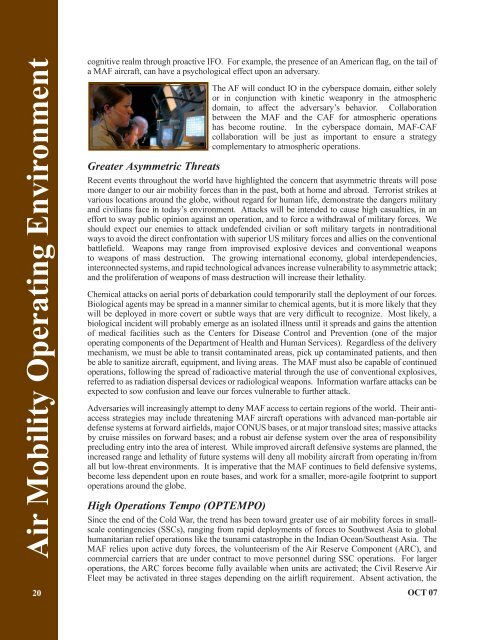Air Mobility Plan, 2008 - The Black Vault
Air Mobility Plan, 2008 - The Black Vault
Air Mobility Plan, 2008 - The Black Vault
Create successful ePaper yourself
Turn your PDF publications into a flip-book with our unique Google optimized e-Paper software.
<strong>Air</strong> <strong>Mobility</strong> Operating Environment<br />
20<br />
cognitive realm through proactive IFO. For example, the presence of an American flag, on the tail of<br />
a MAF aircraft, can have a psychological effect upon an adversary.<br />
<strong>The</strong> AF will conduct IO in the cyberspace domain, either solely<br />
or in conjunction with kinetic weaponry in the atmospheric<br />
domain, to affect the adversary’s behavior. Collaboration<br />
between the MAF and the CAF for atmospheric operations<br />
has become routine. In the cyberspace domain, MAF-CAF<br />
collaboration will be just as important to ensure a strategy<br />
complementary to atmospheric operations.<br />
Greater Asymmetric Threats<br />
Recent events throughout the world have highlighted the concern that asymmetric threats will pose<br />
more danger to our air mobility forces than in the past, both at home and abroad. Terrorist strikes at<br />
various locations around the globe, without regard for human life, demonstrate the dangers military<br />
and civilians face in today’s environment. Attacks will be intended to cause high casualties, in an<br />
effort to sway public opinion against an operation, and to force a withdrawal of military forces. We<br />
should expect our enemies to attack undefended civilian or soft military targets in nontraditional<br />
ways to avoid the direct confrontation with superior US military forces and allies on the conventional<br />
battlefield. Weapons may range from improvised explosive devices and conventional weapons<br />
to weapons of mass destruction. <strong>The</strong> growing international economy, global interdependencies,<br />
interconnected systems, and rapid technological advances increase vulnerability to asymmetric attack;<br />
and the proliferation of weapons of mass destruction will increase their lethality.<br />
Chemical attacks on aerial ports of debarkation could temporarily stall the deployment of our forces.<br />
Biological agents may be spread in a manner similar to chemical agents, but it is more likely that they<br />
will be deployed in more covert or subtle ways that are very difficult to recognize. Most likely, a<br />
biological incident will probably emerge as an isolated illness until it spreads and gains the attention<br />
of medical facilities such as the Centers for Disease Control and Prevention (one of the major<br />
operating components of the Department of Health and Human Services). Regardless of the delivery<br />
mechanism, we must be able to transit contaminated areas, pick up contaminated patients, and then<br />
be able to sanitize aircraft, equipment, and living areas. <strong>The</strong> MAF must also be capable of continued<br />
operations, following the spread of radioactive material through the use of conventional explosives,<br />
referred to as radiation dispersal devices or radiological weapons. Information warfare attacks can be<br />
expected to sow confusion and leave our forces vulnerable to further attack.<br />
Adversaries will increasingly attempt to deny MAF access to certain regions of the world. <strong>The</strong>ir antiaccess<br />
strategies may include threatening MAF aircraft operations with advanced man-portable air<br />
defense systems at forward airfields, major CONUS bases, or at major transload sites; massive attacks<br />
by cruise missiles on forward bases; and a robust air defense system over the area of responsibility<br />
precluding entry into the area of interest. While improved aircraft defensive systems are planned, the<br />
increased range and lethality of future systems will deny all mobility aircraft from operating in/from<br />
all but low-threat environments. It is imperative that the MAF continues to field defensive systems,<br />
become less dependent upon en route bases, and work for a smaller, more-agile footprint to support<br />
operations around the globe.<br />
High Operations Tempo (OPTEMPO)<br />
Since the end of the Cold War, the trend has been toward greater use of air mobility forces in smallscale<br />
contingencies (SSCs), ranging from rapid deployments of forces to Southwest Asia to global<br />
humanitarian relief operations like the tsunami catastrophe in the Indian Ocean/Southeast Asia. <strong>The</strong><br />
MAF relies upon active duty forces, the volunteerism of the <strong>Air</strong> Reserve Component (ARC), and<br />
commercial carriers that are under contract to move personnel during SSC operations. For larger<br />
operations, the ARC forces become fully available when units are activated; the Civil Reserve <strong>Air</strong><br />
Fleet may be activated in three stages depending on the airlift requirement. Absent activation, the<br />
OCT 07
















